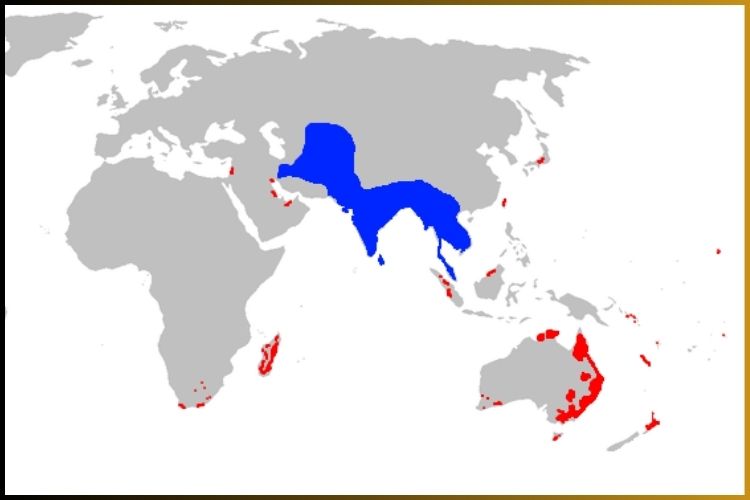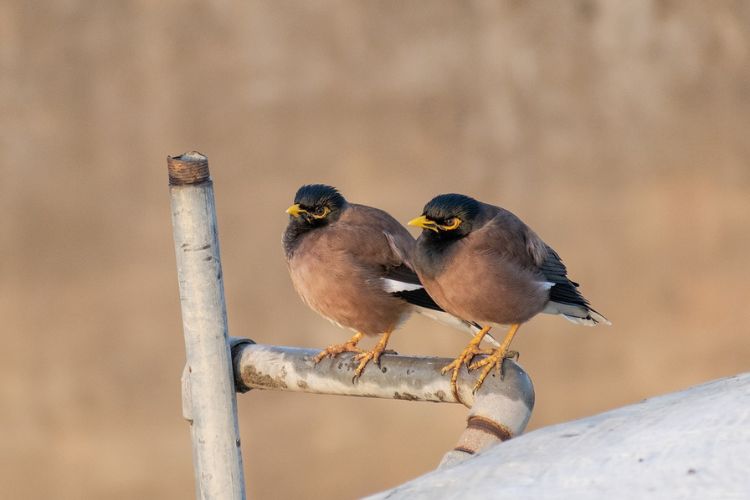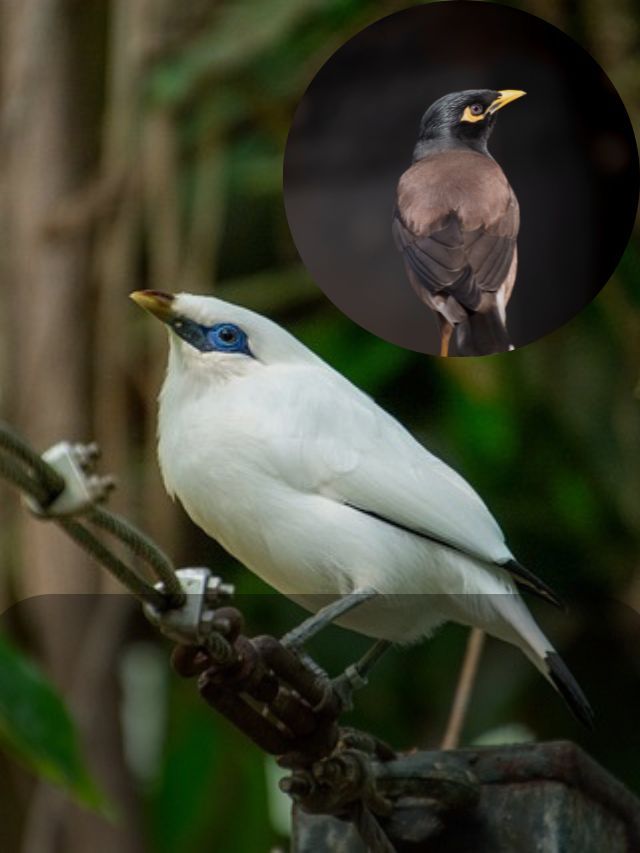Did you know myna birds can learn over 100 human words? These remarkable members of the Starling family captivate bird enthusiasts worldwide.
The Problem: Many potential bird owners overlook mynas as pets. They miss out on these intelligent companions. Most people don’t understand their unique capabilities.
The Solution: This complete guide reveals everything about myna birds. You’ll discover their care requirements and amazing abilities. Our expert advice helps create perfect habitats.
In This Guide You’ll Learn:
- How mynas match parrots in Intelligence
- Essential care tips for healthy mynas
- Expert training techniques for vocal development
- Conservation status and environmental impact
Key Statistics:
- Lifespan: 12-15 years in captivity
- Vocabulary: 100+ words potential
- Daily interaction needed: 3-4 hours
- Learning speed: Masters new words in 2-4 weeks
Ready to explore the extraordinary world of Acridotheres tristis?
Let’s discover why these intelligent avians make such remarkable companions.
Our comprehensive guide starts with their fascinating origins.
What Are Myna Birds?

Myna birds are highly intelligent members of the Starling family.
These remarkable creatures originated in South Asia but now thrive worldwide.
Common mynas showcase distinctive yellow patches around their eyes and beaks.
Their exceptional ability to mimic human speech makes them popular pets.
Most mynas reach 9 inches in length and display glossy black feathers.
These adaptable birds thrive in both urban and rural environments.
Studies show mynas rank among the world’s most intelligent birds.
Let’s explore their unique characteristics and natural habitat in detail.
Origin and Natural Habitat

The natural habitat of myna birds spans tropical and temperate regions.
These adaptable birds originally lived in South Asian forests.
Today, they flourish in diverse environments worldwide.
Common Myna Distribution:
- Native regions: India, Southeast Asia, and Indonesia
- Introduced locations: Australia, New Zealand, and North America
- Preferred habitats: Urban parks, gardens, and farmlands
| Habitat Type | Characteristics | Myna Population Density |
|---|---|---|
| Urban Areas | High human activity, buildings | Very High |
| Woodlands | Dense vegetation, trees | Moderate |
| Grasslands | Open areas, scattered trees | Low to Moderate |
| Agricultural | Farmland, orchards | High |
These resourceful birds have successfully adapted to human settlements.
Their remarkable adaptability contributes to their widespread distribution.
The Remarkable Intelligence of Myna Birds
Myna birds demonstrate exceptional cognitive abilities in the avian world. Their intelligence level matches that of parrots and corvids.
These birds can solve complex puzzles with remarkable ease.
Scientific studies show they possess advanced problem-solving skills. Mynas can remember human faces for extended periods.
Their ability to learn spans both visual and auditory tasks.
Understanding their remarkable mental capabilities helps explain their sophisticated behaviors.
Mimicry and Vocal Abilities
Vocal mimicry in myna birds showcases their extraordinary intelligence. These birds possess highly developed syrinx muscles for sound production. Their vocal range exceeds most other mimicking birds.
Common Sounds Mynas Can Mimic:
- Human speech patterns
- Environmental noises
- Other bird calls
- Mechanical sounds
| Mimicry Type | Learning Time | Accuracy Level |
|---|---|---|
| Human Words | 2-4 weeks | Very High |
| Bird Songs | 1-2 weeks | Exceptional |
| Melodies | 3-5 weeks | High |
| Ambient Sounds | 1-3 weeks | Moderate to High |
Their impressive vocal learning abilities continue to develop throughout their lives. This remarkable skill makes them exceptional communicators in both wild and domestic settings.
Myna Birds as Pets: What to Know

First-time myna bird owners should understand their unique care requirements.
These intelligent companions need specific housing and attention.
Proper care ensures their physical and mental well-being. Mynas require at least 3-4 hours of daily interaction.
Their living space must accommodate their active nature. Regular veterinary care supports their long-term health.
Let’s explore the essential aspects of myna bird care in detail.
Housing and Cage Requirements
Proper housing plays a crucial role in a myna bird’s well-being. The cage should measure at least 36x24x36 inches for a single bird. Appropriate cage setup ensures both physical and mental stimulation.
Essential Cage Features:
- Multiple perches of varying diameters
- Interactive toys and puzzles
- Food and water stations
- Exercise areas
| Housing Element | Minimum Requirement | Recommended Size/Amount |
|---|---|---|
| Cage Size | 36x24x36 inches | 48x36x48 inches |
| Perch Count | 3 different sizes | 5-6 varied perches |
| Play Areas | 2 separate spaces | 3-4 activity zones |
| Toy Rotation | Weekly changes | Bi-weekly updates |
Creating an enriching environment promotes natural behaviors and prevents boredom. Regular updates to their living space support their active lifestyle.
Social Behavior and Communication

Myna birds display complex social structures in their natural habitat.
These highly social creatures form strong bonds within their groups.
Communication patterns vary from simple calls to elaborate displays.
Mynas use specific vocalizations to mark territory and attract mates.
Their social intelligence enables them to adapt to various group dynamics.
Understanding their social nature is crucial for both wild and captive birds.
H3: Mating and Reproduction
The breeding cycle of myna birds follows distinct seasonal patterns. These birds demonstrate strong monogamous behavior throughout their lives. Successful reproduction depends on specific environmental conditions.
Breeding Season Characteristics:
- Peak breeding months: March to July
- Nest building period: 5-7 days
- Incubation duration: 13-14 days
- Average clutch size: 4-5 eggs
| Breeding Stage | Duration | Key Behaviors |
|---|---|---|
| Courtship | 2-3 weeks | Singing, displaying |
| Nesting | 1 week | Material gathering |
| Incubation | 2 weeks | Egg turning, warming |
| Fledgling Care | 3-4 weeks | Feeding, protection |
Both parents actively participate in raising their young. This cooperative approach ensures higher survival rates for their offspring.
H2: Conservation Status and Environmental Impact
Myna birds demonstrate significant ecological influence in their habitats. Their adaptability makes them successful in various environments. Population growth affects local biodiversity patterns. Conservation efforts focus on managing their presence sustainably. Their impact varies across different geographical regions. Understanding their role helps develop effective management strategies.
Let’s examine their environmental impact and conservation needs more closely.
H3: Impact on Local Ecosystems
The ecological effects of myna birds vary significantly across regions. These adaptable birds can influence native species populations. Their presence creates unique challenges for ecosystem management.
Key Environmental Impacts:
- Competition with native birds
- Changes in local seed dispersal
- Modification of urban ecosystems
- Effects on insect populations
| Impact Area | Effect Level | Management Priority |
|---|---|---|
| Native Birds | High | Immediate Action |
| Urban Areas | Moderate | Ongoing Monitoring |
| Agriculture | Variable | Seasonal Assessment |
| Biodiversity | Medium to High | Regular Review |
Balanced management approaches help maintain ecological harmony while respecting these intelligent birds.
H3: Conservation Efforts and Management
Conservation strategies focus on sustainable population control. Effective management programs require community involvement. These initiatives balance wildlife preservation with ecosystem protection.
Key Management Approaches:
- Population monitoring systems
- Habitat modification programs
- Public education initiatives
- Research-based interventions
| Strategy Type | Implementation Time | Success Rate |
|---|---|---|
| Monitoring | Year-round | High |
| Education | Ongoing | Moderate |
| Control Measures | Seasonal | Variable |
| Habitat Management | Long-term | Good |
Successful conservation requires continuous adaptation of management strategies. These efforts ensure sustainable coexistence with native wildlife.
Common Questions About Myna Birds
Frequently asked questions help understand these fascinating birds better. These answers provide essential information for bird enthusiasts. Clear information supports better care and appreciation.
Q1: How long do myna birds live as pets?
Myna birds typically live 12-15 years in captivity. Proper care can extend their lifespan significantly. Regular veterinary care ensures optimal health.
Q2: Can myna birds really talk like parrots?
Vocal abilities of mynas often match or exceed parrots. They can learn hundreds of words and phrases. Their clarity of speech is often remarkable.
Q3: Are myna birds legal to keep as pets?
Pet ownership regulations vary by location. Some regions require special permits. Always check local laws before acquiring a myna.
Q4: What do myna birds eat in the wild?
Natural diet includes:
- Insects and small invertebrates
- Fruits and berries
- Seeds and grains
- Nectar from flowers
Q5: How can you tell male and female myna birds apart?
Gender identification relies on subtle differences. Males and females look very similar externally. Behavioral cues often provide better indicators than physical characteristics.

